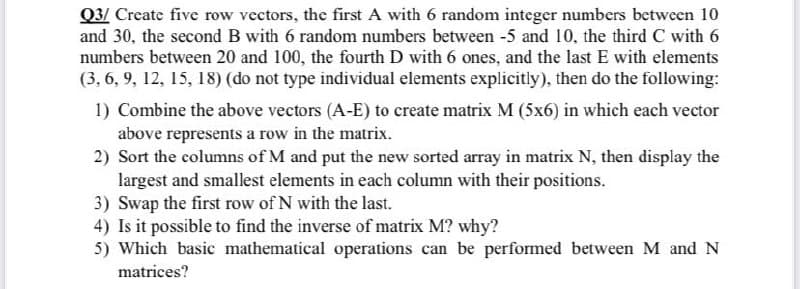Q3/ Create five row vectors, the first A with 6 random integer numbers between 10 and 30, the second B with 6 random numbers between -5 and 10, the third C with 6 numbers between 20 and 100, the fourth D with 6 ones, and the last E with elements (3, 6, 9, 12, 15, 18) (do not type individual elements explicitly), then do the following: 1) Combine the above vectors (A-E) to create matrix M (5x6) in which each vector above represents a row in the matrix. 2) Sort the columns of M and put the new sorted array in matrix N, then display the largest and smallest elements in each column with their positions. 3) Swap the first row of N with the last. 4) Is it possible to find the inverse of matrix M? why?
Q3/ Create five row vectors, the first A with 6 random integer numbers between 10 and 30, the second B with 6 random numbers between -5 and 10, the third C with 6 numbers between 20 and 100, the fourth D with 6 ones, and the last E with elements (3, 6, 9, 12, 15, 18) (do not type individual elements explicitly), then do the following: 1) Combine the above vectors (A-E) to create matrix M (5x6) in which each vector above represents a row in the matrix. 2) Sort the columns of M and put the new sorted array in matrix N, then display the largest and smallest elements in each column with their positions. 3) Swap the first row of N with the last. 4) Is it possible to find the inverse of matrix M? why?
Computer Networking: A Top-Down Approach (7th Edition)
7th Edition
ISBN:9780133594140
Author:James Kurose, Keith Ross
Publisher:James Kurose, Keith Ross
Chapter1: Computer Networks And The Internet
Section: Chapter Questions
Problem R1RQ: What is the difference between a host and an end system? List several different types of end...
Related questions
Question
i need the answer quickly

Transcribed Image Text:Q3/ Create five row vectors, the first A with 6 random integer numbers between 10
and 30, the second B with 6 random numbers between -5 and 10, the third C with 6
numbers between 20 and 100, the fourth D with 6 ones, and the last E with elements
(3, 6, 9, 12, 15, 18) (do not type individual elements explicitly), then do the following:
1) Combine the above vectors (A-E) to create matrix M (5x6) in which each vector
above represents a row in the matrix.
2) Sort the columns of M and put the new sorted array in matrix N, then display the
largest and smallest elements in each column with their positions.
3) Swap the first row of N with the last.
4) Is it possible to find the inverse of matrix M? why?
5) Which basic mathematical operations can be performed between M and N
matrices?
Expert Solution
This question has been solved!
Explore an expertly crafted, step-by-step solution for a thorough understanding of key concepts.
Step by step
Solved in 2 steps with 1 images

Recommended textbooks for you

Computer Networking: A Top-Down Approach (7th Edi…
Computer Engineering
ISBN:
9780133594140
Author:
James Kurose, Keith Ross
Publisher:
PEARSON

Computer Organization and Design MIPS Edition, Fi…
Computer Engineering
ISBN:
9780124077263
Author:
David A. Patterson, John L. Hennessy
Publisher:
Elsevier Science

Network+ Guide to Networks (MindTap Course List)
Computer Engineering
ISBN:
9781337569330
Author:
Jill West, Tamara Dean, Jean Andrews
Publisher:
Cengage Learning

Computer Networking: A Top-Down Approach (7th Edi…
Computer Engineering
ISBN:
9780133594140
Author:
James Kurose, Keith Ross
Publisher:
PEARSON

Computer Organization and Design MIPS Edition, Fi…
Computer Engineering
ISBN:
9780124077263
Author:
David A. Patterson, John L. Hennessy
Publisher:
Elsevier Science

Network+ Guide to Networks (MindTap Course List)
Computer Engineering
ISBN:
9781337569330
Author:
Jill West, Tamara Dean, Jean Andrews
Publisher:
Cengage Learning

Concepts of Database Management
Computer Engineering
ISBN:
9781337093422
Author:
Joy L. Starks, Philip J. Pratt, Mary Z. Last
Publisher:
Cengage Learning

Prelude to Programming
Computer Engineering
ISBN:
9780133750423
Author:
VENIT, Stewart
Publisher:
Pearson Education

Sc Business Data Communications and Networking, T…
Computer Engineering
ISBN:
9781119368830
Author:
FITZGERALD
Publisher:
WILEY